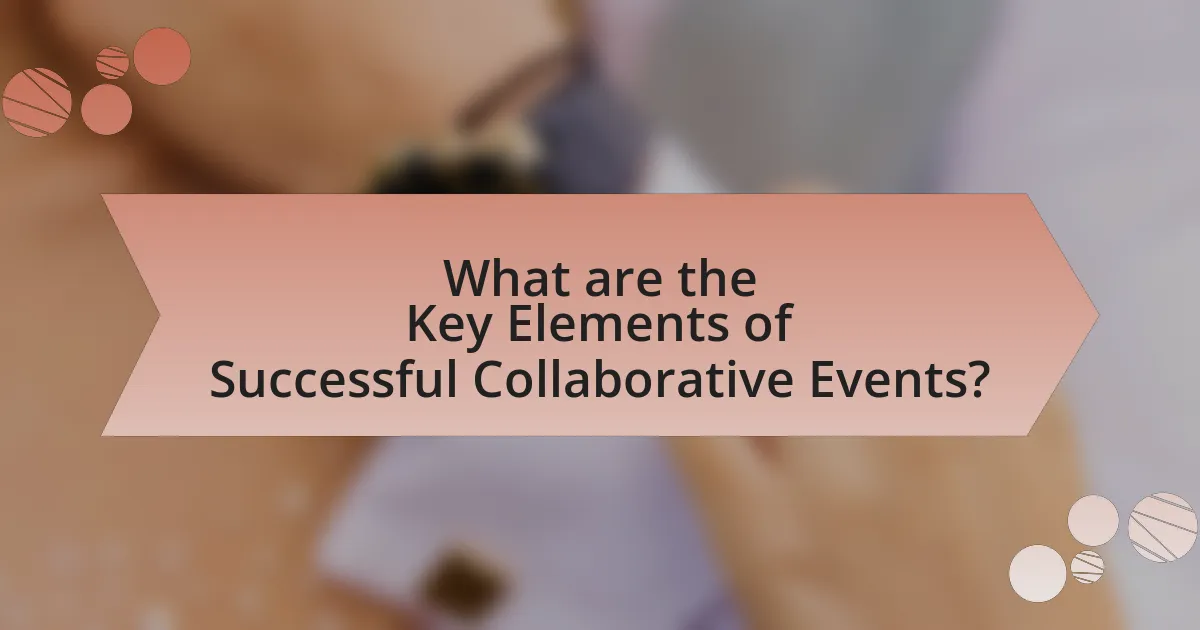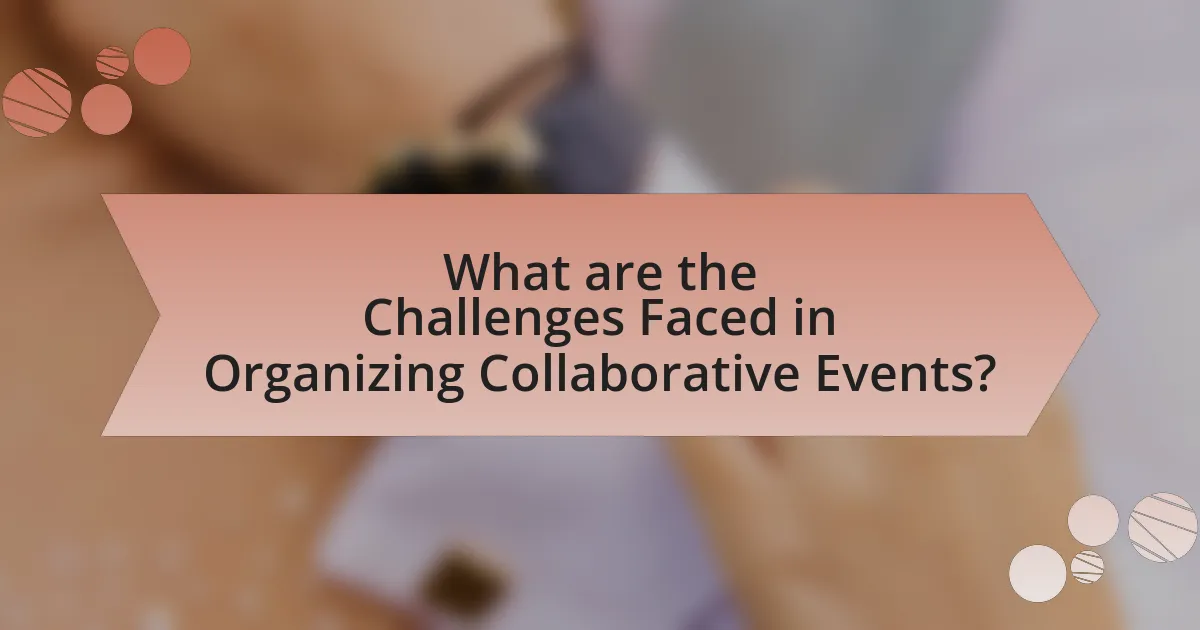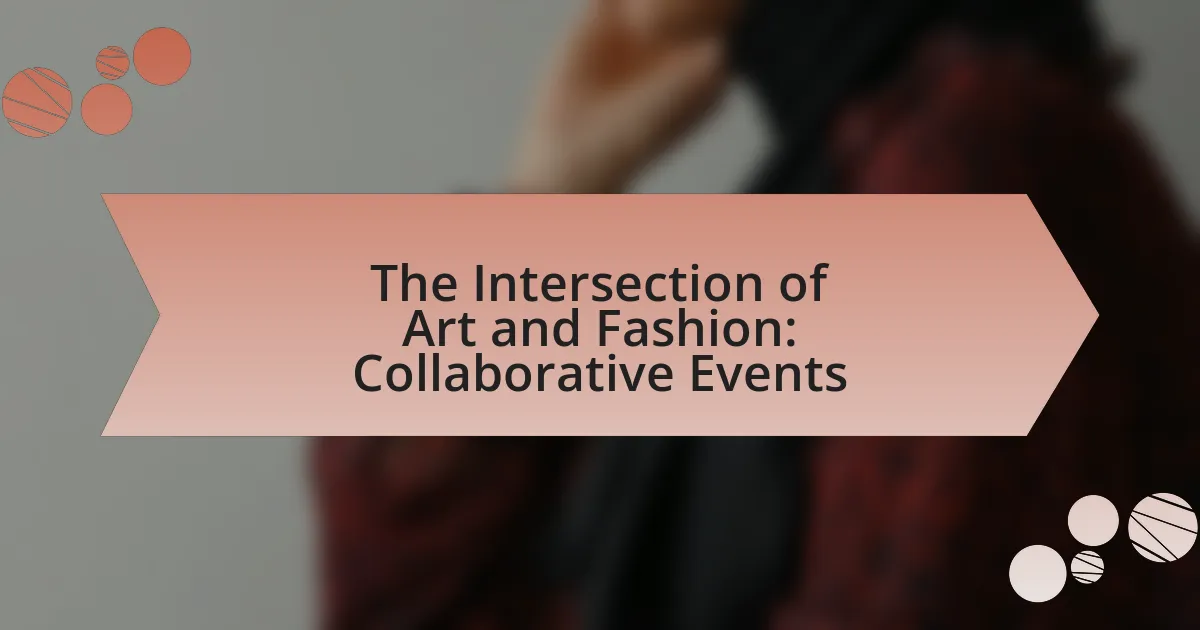The article focuses on collaborative events at the intersection of art and fashion, highlighting how artists and fashion designers work together to create unique experiences that blend both disciplines. It discusses various types of collaborative events, such as exhibitions and fashion shows, and examines how these initiatives enhance visibility for both fields while fostering creativity and networking opportunities. Key elements for successful collaborations, including communication, defined roles, and effective planning, are outlined, along with the challenges organizers face, such as budget constraints and logistical complexities. Additionally, the article explores future trends, emphasizing the role of technology and sustainability in shaping the landscape of art and fashion collaborations.

What are Collaborative Events in the Intersection of Art and Fashion?
Collaborative events in the intersection of art and fashion are initiatives where artists and fashion designers work together to create unique experiences or products that blend both disciplines. These events often include exhibitions, runway shows, and installations that showcase the synergy between artistic expression and fashion design. For example, the collaboration between artist Yayoi Kusama and Louis Vuitton resulted in a collection that featured Kusama’s iconic polka dots on fashion items, illustrating how art can influence and enhance fashion aesthetics. Such collaborations not only promote creativity but also attract diverse audiences, bridging gaps between different cultural sectors.
How do art and fashion collaborate in these events?
Art and fashion collaborate in events through the integration of artistic expression into fashion design and presentation. Designers often draw inspiration from various art forms, such as painting, sculpture, and performance art, to create unique collections that reflect artistic themes. For instance, the collaboration between fashion designers and contemporary artists, like the partnership between Louis Vuitton and Takashi Murakami, showcases how art can enhance the visual appeal and narrative of fashion items. Additionally, events like fashion weeks often feature art installations and performances that complement runway shows, creating a multi-sensory experience that blurs the lines between the two disciplines. This synergy not only elevates the fashion experience but also promotes the visibility of artists within the fashion industry.
What types of collaborative events exist between art and fashion?
Collaborative events between art and fashion include exhibitions, fashion shows, and artist-designed collections. Exhibitions often showcase the work of artists alongside fashion designers, highlighting the creative synergy between the two fields, such as the “Fashion and Art” exhibition at the Museum of Modern Art in New York. Fashion shows may feature artistic elements, like the collaboration between designer Alexander McQueen and artist Damien Hirst, which resulted in unique runway presentations. Additionally, artist-designed collections, such as those by Yayoi Kusama for Louis Vuitton, merge artistic vision with fashion, creating limited-edition pieces that reflect both disciplines. These events demonstrate the ongoing dialogue and partnership between art and fashion, enriching both industries.
How do these events enhance the visibility of both art and fashion?
Collaborative events enhance the visibility of both art and fashion by creating a platform where artists and designers can showcase their work to a broader audience. These events often attract media attention, leading to increased coverage in fashion and art publications, which amplifies exposure. For instance, events like fashion weeks or art fairs frequently feature installations that merge artistic expression with fashion design, drawing in diverse crowds and fostering cross-industry dialogue. This synergy not only elevates individual brands but also promotes cultural appreciation, as seen in events like the Met Gala, which celebrates both fashion and art through themed exhibitions.
Why are collaborative events important for artists and designers?
Collaborative events are important for artists and designers because they foster creativity, innovation, and networking opportunities. These events allow individuals from diverse backgrounds to share ideas and techniques, leading to unique artistic expressions and solutions. For instance, a study by the National Endowment for the Arts highlights that collaboration can enhance artistic quality and increase audience engagement, as artists often draw inspiration from one another’s perspectives and skills. Furthermore, collaborative events can expand professional networks, providing artists and designers with access to new markets and potential partnerships, which is crucial for career growth in the competitive fields of art and design.
What opportunities do these events create for networking?
Collaborative events at the intersection of art and fashion create significant networking opportunities by bringing together diverse professionals from both industries. These events facilitate connections among artists, designers, influencers, and industry leaders, allowing participants to share ideas, collaborate on projects, and explore potential partnerships. For instance, a study by the National Endowment for the Arts highlights that networking events in creative fields can lead to increased collaboration and innovation, as individuals exchange insights and resources. This dynamic environment fosters relationships that can result in future collaborations, joint ventures, and expanded professional networks.
How do collaborative events influence trends in both industries?
Collaborative events significantly influence trends in both the art and fashion industries by fostering innovation and cross-pollination of ideas. These events create platforms where artists and designers can showcase their work together, leading to unique, trend-setting collaborations that often redefine aesthetic standards. For instance, the partnership between fashion designer Alexander McQueen and artist Damien Hirst resulted in collections that merged high fashion with contemporary art, influencing both industries’ trajectories. Such collaborations not only attract diverse audiences but also generate media buzz, which amplifies their impact on consumer preferences and market trends.

What are the Key Elements of Successful Collaborative Events?
The key elements of successful collaborative events include clear communication, defined roles, mutual goals, and effective planning. Clear communication ensures that all parties understand their responsibilities and expectations, which is crucial for coordination. Defined roles help participants know their specific contributions, preventing overlap and confusion. Mutual goals align the interests of all collaborators, fostering a shared vision that drives the event’s success. Effective planning involves detailed logistics, timelines, and resource allocation, which are essential for executing the event smoothly. These elements are supported by research indicating that successful collaborations often hinge on these foundational aspects, leading to enhanced creativity and innovation in events that merge art and fashion.
How do organizers select participants for these events?
Organizers select participants for collaborative art and fashion events based on criteria such as artistic merit, relevance to the theme, and potential for audience engagement. They often review portfolios, past work, and proposals to assess how well participants align with the event’s vision. For instance, events may prioritize artists and designers who have demonstrated innovation and creativity in their previous projects, ensuring a high-quality experience for attendees. Additionally, organizers may consider diversity and representation to enrich the event’s cultural narrative, thereby enhancing its appeal and impact.
What criteria are used to ensure a successful collaboration?
Successful collaboration in the context of art and fashion relies on clear communication, shared goals, mutual respect, and complementary skills among participants. Clear communication ensures that all parties understand their roles and expectations, which is vital for coordination. Shared goals align the vision and objectives of the collaboration, fostering a unified direction. Mutual respect among collaborators promotes a positive working environment, encouraging creativity and innovation. Complementary skills enhance the collaboration by bringing diverse expertise that enriches the project. These criteria are supported by studies indicating that effective teamwork significantly improves project outcomes in creative industries.
How does the venue impact the success of the event?
The venue significantly impacts the success of an event by influencing attendee experience, accessibility, and overall atmosphere. A well-chosen venue enhances engagement through its aesthetic appeal and functionality, which can lead to higher attendee satisfaction and participation rates. For instance, a study by Eventbrite found that 78% of attendees consider the venue’s ambiance crucial to their overall experience. Additionally, the location affects accessibility; venues situated in easily reachable areas tend to attract larger crowds, as evidenced by the increased attendance rates reported for events held in central urban locations compared to those in remote areas. Thus, the venue plays a critical role in shaping the event’s success through its design, location, and ability to create a memorable experience.
What role does marketing play in collaborative events?
Marketing plays a crucial role in collaborative events by facilitating communication and engagement between diverse stakeholders, including artists, brands, and audiences. Effective marketing strategies enhance visibility and attract participants, ensuring that the collaborative event reaches its target demographic. For instance, promotional campaigns utilizing social media platforms can increase attendance and foster community involvement, as evidenced by the success of events like the Art Basel Miami Beach, which leverages extensive marketing to draw in over 80,000 visitors annually. This demonstrates that strategic marketing not only promotes the event but also amplifies the collaborative efforts of the involved parties, ultimately leading to a more impactful experience for all participants.
How can social media be leveraged to promote these events?
Social media can be leveraged to promote collaborative events in art and fashion by utilizing targeted advertising, engaging content, and influencer partnerships. Targeted advertising allows event organizers to reach specific demographics interested in art and fashion, increasing visibility among potential attendees. Engaging content, such as behind-the-scenes videos, artist interviews, and interactive posts, can create excitement and encourage sharing, further amplifying reach. Additionally, partnerships with influencers who resonate with the target audience can enhance credibility and attract followers to the event. According to a study by the Pew Research Center, 72% of adults use social media, making it a powerful tool for event promotion.
What strategies can enhance audience engagement during the event?
Interactive activities, such as live demonstrations and audience participation, can significantly enhance audience engagement during events. These strategies create immersive experiences that encourage attendees to actively participate rather than passively observe. For instance, incorporating Q&A sessions allows the audience to interact directly with speakers, fostering a sense of connection and involvement. Additionally, utilizing social media platforms for real-time feedback and sharing can amplify engagement, as studies show that events with active social media interaction see a 30% increase in audience involvement. Furthermore, offering hands-on workshops related to art and fashion can deepen the audience’s understanding and appreciation, leading to a more memorable experience.

What are the Challenges Faced in Organizing Collaborative Events?
Organizing collaborative events faces several challenges, including communication barriers, differing objectives among stakeholders, and logistical complexities. Effective communication is crucial, as misunderstandings can lead to misaligned goals and expectations. For instance, when artists and fashion designers collaborate, their creative visions may not align, resulting in conflicts that hinder the event’s success. Additionally, coordinating schedules and resources among multiple parties can complicate logistics, often leading to delays or budget overruns. A study by the Event Marketing Institute found that 70% of event organizers cite collaboration difficulties as a significant barrier to successful event execution, highlighting the prevalence of these challenges in the industry.
What common obstacles do organizers encounter?
Organizers commonly encounter budget constraints as a significant obstacle. Limited financial resources can restrict the scope of events, affecting venue selection, marketing efforts, and the ability to hire skilled professionals. According to a survey by Eventbrite, 40% of event organizers cite budget limitations as a primary challenge, which directly impacts their planning and execution capabilities. Additionally, logistical issues such as coordinating schedules, managing vendor relationships, and ensuring timely delivery of materials further complicate the organization process. These challenges highlight the complexities involved in successfully executing collaborative events in the art and fashion sectors.
How can budget constraints affect the planning of these events?
Budget constraints significantly limit the scope and scale of planning collaborative events in art and fashion. When financial resources are restricted, organizers must prioritize essential elements, often leading to compromises in venue selection, talent acquisition, and marketing efforts. For instance, a limited budget may necessitate choosing a smaller venue, which can reduce audience capacity and impact the overall experience. Additionally, budget limitations can restrict the ability to hire high-profile artists or designers, thereby affecting the event’s appeal and potential attendance. According to a study by the National Endowment for the Arts, events with tighter budgets often result in reduced programming quality, which can diminish audience engagement and satisfaction.
What are the logistical challenges in coordinating between different creative fields?
Coordinating between different creative fields presents logistical challenges such as differing timelines, communication barriers, and resource allocation issues. Different creative disciplines often operate on unique schedules, making it difficult to synchronize project timelines effectively. For instance, artists may require more time for conceptual development, while fashion designers may work on tighter deadlines for production. Communication barriers arise from varying terminologies and practices across fields, which can lead to misunderstandings and misalignment of goals. Additionally, resource allocation becomes complex when balancing budgets, materials, and personnel that cater to diverse creative needs, often resulting in conflicts over priorities and funding. These challenges necessitate careful planning and clear communication strategies to ensure successful collaboration.
How can these challenges be overcome?
Collaborative events at the intersection of art and fashion can overcome challenges by fostering open communication and establishing clear objectives among stakeholders. Effective collaboration requires regular meetings and feedback loops to ensure all parties are aligned on vision and goals. Research indicates that successful partnerships often involve shared resources and expertise, which can enhance creativity and innovation. For instance, a study by the Harvard Business Review highlights that organizations that prioritize collaboration see a 20-25% increase in productivity. By implementing structured frameworks for collaboration, such as joint planning sessions and co-creation workshops, stakeholders can navigate potential conflicts and leverage diverse perspectives to create impactful events.
What best practices can ensure smooth collaboration between artists and designers?
Effective communication is the best practice to ensure smooth collaboration between artists and designers. Clear and open dialogue allows both parties to express their ideas, expectations, and feedback, which fosters a shared understanding of the project goals. Regular check-ins and updates can help maintain alignment and address any issues promptly. Additionally, establishing a collaborative workflow that includes shared tools and platforms for project management enhances transparency and efficiency. Research indicates that teams with strong communication practices are 25% more productive, highlighting the importance of this approach in creative collaborations.
How can feedback from past events improve future collaborations?
Feedback from past events can significantly enhance future collaborations by identifying strengths and weaknesses in the collaborative process. Analyzing feedback allows teams to understand what worked well, such as effective communication strategies or successful artistic integrations, and what did not, like logistical challenges or misaligned goals. For instance, a study by the Harvard Business Review found that organizations that actively seek and implement feedback improve their project outcomes by up to 30%. This data underscores the importance of feedback in refining collaborative practices, ensuring that future events are more cohesive and aligned with participants’ expectations.
What are the Future Trends in Art and Fashion Collaborative Events?
Future trends in art and fashion collaborative events include increased integration of technology, sustainability initiatives, and immersive experiences. The use of augmented reality (AR) and virtual reality (VR) is expected to enhance audience engagement, allowing participants to interact with art and fashion in innovative ways. For instance, brands like Balenciaga have already experimented with digital fashion shows that utilize VR technology, showcasing how these tools can redefine traditional presentations.
Sustainability is also becoming a focal point, with collaborations emphasizing eco-friendly materials and practices. Events like the Fashion for Good initiative highlight how the fashion industry is increasingly partnering with artists to promote sustainable practices, reflecting a growing consumer demand for environmentally responsible products.
Moreover, immersive experiences that blend art installations with fashion showcases are on the rise, as seen in events like the Museum of Ice Cream, which combines interactive art with fashion elements, creating a multi-sensory experience for attendees. These trends indicate a shift towards more dynamic, responsible, and engaging collaborative events in the art and fashion sectors.
How is technology shaping the future of these events?
Technology is shaping the future of collaborative art and fashion events by enhancing interactivity and accessibility. Innovations such as augmented reality (AR) and virtual reality (VR) allow attendees to engage with art and fashion in immersive ways, creating unique experiences that transcend traditional boundaries. For instance, brands like Balenciaga have utilized VR to showcase collections, enabling global audiences to participate in fashion shows remotely. Additionally, data analytics and social media platforms facilitate real-time feedback and engagement, allowing organizers to tailor events to audience preferences. This integration of technology not only broadens the reach of events but also fosters deeper connections between artists, designers, and attendees, ultimately transforming the landscape of collaborative events in art and fashion.
What emerging themes are likely to influence future collaborations?
Emerging themes likely to influence future collaborations in the intersection of art and fashion include sustainability, technology integration, and cultural diversity. Sustainability is increasingly prioritized as brands seek eco-friendly materials and practices, reflecting consumer demand for responsible production. Technology integration, such as augmented reality and digital fashion, enhances the creative process and consumer engagement, allowing for innovative experiences. Cultural diversity fosters inclusivity and representation, encouraging collaborations that celebrate various artistic expressions and backgrounds. These themes are supported by industry trends, such as the rise of sustainable fashion brands and the growing popularity of digital art platforms, indicating a shift towards more conscious and inclusive collaborative efforts.
What Tips Can Help Organizers Create Successful Collaborative Events?
To create successful collaborative events, organizers should prioritize clear communication among all stakeholders involved. Effective communication ensures that everyone understands their roles, responsibilities, and the overall vision of the event. Research indicates that projects with well-defined communication strategies are 50% more likely to succeed, as highlighted in the Project Management Institute’s “Pulse of the Profession” report. Additionally, establishing a shared goal fosters collaboration, as it aligns the efforts of diverse participants towards a common outcome, enhancing creativity and innovation.
